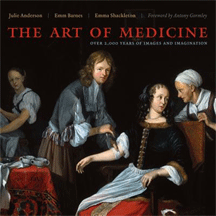By Janice Simon
Wunderkammer. The word calls up images of rooms full of ceiling-high dark wood shelves and innumerable cabinets and glass vitrines filled with natural and man-made objects, curiosities, and sometimes revolting remnants of scientific and historical journeys throughout the world. Sir Henry Wellcome (1853-1936), born in the American West and settling in London in 1880 to establish with fellow American Silas Burroughs a highly successful pharmaceutical company, created a gigantic Wunderkammer collection merging his interests in medicine and anthropology, science and art. Numbering over a million objects, Wellcome’s collection resides today in London’s Wellcome Library, the city’s Science Museum, and in the new cultural center, the Wellcome Collection. This large, beautifully illustrated book celebrates the Wellcome Collection by sharing many of the objects residing there along with more contemporary images inspired by the latest discoveries in medicine. It is a gallery in book form.
The Art of Medicine intentionally echoes a Wunderkammer exhibition with its myriad juxtapositions of manuscript pages, engravings, watercolors, oil paintings, photographs, sculptures, masks, amulets, and anatomical figures. Divided into six thematic chapters with multiple subthemes, the book presents a virtual world overview from the Renaissance to the present of how artists have visually addressed the human body and its illnesses. Although works from Asia and Africa are peppered throughout, the Western tradition clearly dominated Wellcome’s collection. Beginning with “Mapping the Body,” the organization of this visual Wunderkammer unfolds showing the role of medicine in history, the various illnesses that have plagued humankind from Cholera to HIV, the range of treatments including bloodletting, acupuncture, amputation, and magic, a consideration of mental illness and the fascination with phrenology and physiognomy, and ends with posters advertising how to stay well by personal cleanliness, vaccinations, and not sharing needles. Many wondrous images fill the pages of this book including the social caricatures of Hogarth, Goya, Rowlandson, and Japanese printmaker Kuniyoshi, a scare-devil figure from the Nicobar Islands, an Iranian astrological manuscript page, Francis Crick’s sketches of the spiraling helix and nucelotides, and color enhanced electron micrographs of the human egg and sperm. I keep on returning to the electron micrographs of human embryos implanting in the uterus because they seem so otherworldly.
Every chapter and sub-section has a short, lively written introduction placing the topic in historical context with frequently surprising information. For example, in “The Chest and Torso” section, even though no images from ancient Greece are included, the reader finds out that the Greeks believed that the woman’s womb moved about inside the body connecting itself to any of the other organs, causing distressing problems to be sure. Each illustration is fully identified and then, as if on an exhibition wall, a concise informative explanation “label” is inserted beside it. This textual organization makes the book one easy to dip into at any point. Indeed, it is really not a book to be read through from beginning to end (though one could do so easily) but rather one to skim, study a few images intently, read about them quickly, put the book down and then later pick it up again in another section depending upon what catches one’s attention. Directed to the general reader, this is a book of many pleasures: textual yet overwhelmingly visual, factual yet fun, subjects seemingly familiar yet a bounty of surprises. The Art of Medicine is the best kind of coffee table book: one that compels frequent browsing, and in turn, continually rewards.
Janice Simon (ΦBK, SUNY at Buffalo, 1977) is the Josiah Meigs Distinguished Teaching Professor of Art History at the University of Georgia and a resident member of the Alpha of Georgia chapter of Phi Beta Kappa.




